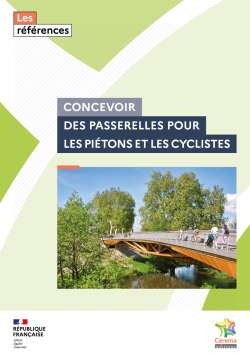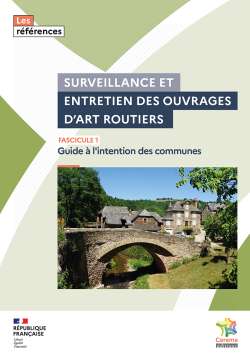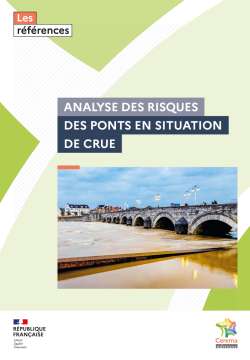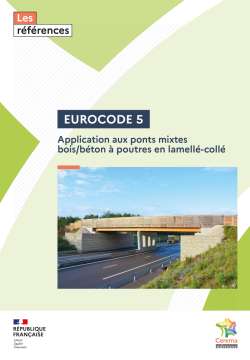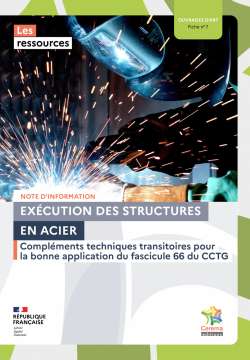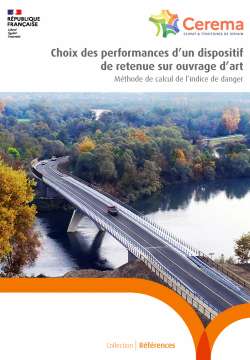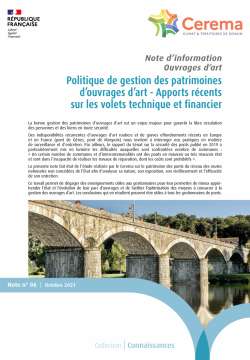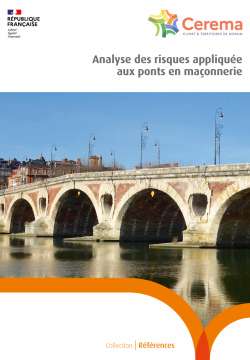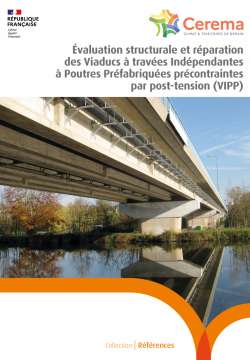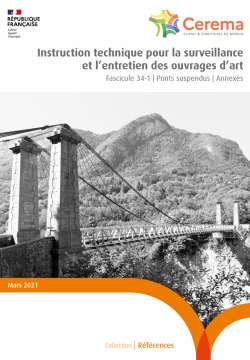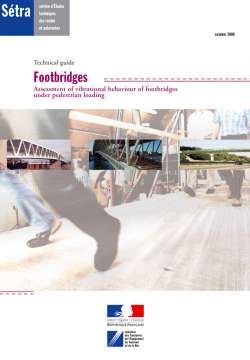
Technical guide - Footbridges
Assessment of vibrational behaviour of footbridges under pedestrian loading
These guidelines round up the state of current knowledge on dynamic behaviour of footbridges under pedestrian loading. An analytical methodology and recommendations are also proposed to guide the designer of a new footbridge when considering the resulting dynamic effects.
The methodology is based on the footbridge classification conceptand on the required comfort level and relies on interpretation of results obtained from tests performed on the Solferino footbridge and on an experimental platform
These guidelines round up the state of current knowledge on dynamic behaviour of footbridges under pedestrian loading. An analytical methodology and recommendations are also proposed to guide the designer of a new footbridge when considering the resulting dynamic effects.
The methodology is based on the footbridge classification concept (as a function of traffic level) and on the required comfort level and relies on interpretation of results obtained from tests performed on the Solferino footbridge and on an experimental platform.
These guidelines are aimed at Owners, designers and engineers.
This document covers the following topics:
* a description of the dynamic phenomena specific to footbridges and identification of the parameters which have an impact on the dimensioning of such structures;
* a methodology for the dynamic analysis of footbridges based on a classification according to the traffic level;
* a presentation of the practical methods for calculation of natural frequencies and modes, as well as structural response to loading;
* recommendations for the drafting of design and construction documents.
Supplementary theoretical (reminder of structural dynamics, pedestrian load modelling) and practical (damping systems, examples of recent footbridges, typical calculations) data are also provided in the guideline appendices.
Contents
MAIN NOTATIONS................................................................................................................ 3
INTRODUCTION.................................................................................................................... 4
FOREWORD............................................................................................................................ 6
1 FOOTBRIDGE DYNAMICS.......................................................................................... 7
1.1 STRUCTURE AND FOOTBRIDGE DYNAMICS................................................................... 7
1.2 PEDESTRIAN LOADING............................................................................................... 10
1.3 PARAMETERS THAT AFFECT DIMENSIONING: FREQUENCY, COMFORT THRESHOLD, COMFORT CRITERION, ETC. .................................................................................................... 25
1.4 IMPROVEMENT OF DYNAMIC BEHAVIOUR.................................................................. 27
2 FOOTBRIDGE DYNAMIC ANALYSIS METHODOLOGY................................... 30
2.1 STAGE 1: DETERMINATION OF FOOTBRIDGE CLASS.................................................... 31
2.2 STAGE 2: CHOICE OF COMFORT LEVEL BY THE OWNER............................................. 31
2.3 STAGE 3: DETERMINATION OF FREQUENCIES AND OF THE NEED TO PERFORM DYNAMIC LOAD CASE CALCULATIONS OR NOT....................................................................................... 32
2.4 STAGE 4 IF NECESSARY: CALCULATION WITH DYNAMIC LOAD CASES. ...................... 34
2.5 STAGE 5: MODIFICATION OF THE PROJECT OR OF THE FOOTBRIDGE........................... 37
2.6 STRUCTURAL CHECKS UNDER DYNAMIC LOADS........................................................ 40
3 CHAPTER 3: PRACTICAL DESIGN METHODS................................................... 43
3.1 PRACTICAL DESIGN METHODS................................................................................... 43
3.2 DYNAMIC CALCULATION APPLIED TO FOOTBRIDGES................................................. 44
4 CHAPTER 4: DESIGN AND WORKS SPECIFICATION, TESTING................... 54
4.1 EXAMPLES OF ITEMS FOR A FOOTBRIDGE DYNAMIC DESIGN SPECIFICATION.............. 54
4.2 EXAMPLES OF ITEMS TO BE INSERTED IN THE PARTICULAR WORKS TECHNICAL SPECIFICATION FOR A FOOTBRIDGE........................................................................................ 54
4.3 DYNAMIC TESTS OR TESTS ON FOOTBRIDGES............................................................. 54
1 APPENDIX 1: REMINDERS OF THE DYNAMICS OF CONSTRUCTIONS...... 58
1.1 A SIMPLE OSCILLATOR.............................................................................................. 58
1.2 LINEAR SYSTEMS AT NDOF...................................................................................... 67
1.3 CONTINUOUS ELASTIC SYSTEMS................................................................................ 76
1.4 DISCRETISATION OF THE CONTINUOUS SYSTEMS....................................................... 82
2 APPENDIX 2: MODELLING OF THE PEDESTRIAN LOAD............................... 86
2.1 WALKING.................................................................................................................. 87
2.2 RUNNING................................................................................................................... 91
3 : DAMPING SYSTEMS......................................................................... 94
3.1 VISCO-ELASTIC DAMPERS.......................................................................................... 94
3.2 VISCOUS DAMPERS.................................................................................................... 95
3.3 TUNED MASS DAMPERS (TMD)................................................................................. 97
3.4 TUNED LIQUID DAMPERS......................................................................................... 100
3.5 COMPARATIVE TABLE............................................................................................. 101
4 APPENDIX 4: EXAMPLES OF FOOTBRIDGES................................................... 103
4.1 WARREN-TYPE LATERAL BEAMS: CAVAILLON FOOTBRIDGE................................... 103
4.2 STEEL BOX-GIRDER: STADE DE FRANCE FOOTBRIDGE............................................. 103
4.3 RIBBED SLAB: NOISY-LE-GRAND FOOTBRIDGE....................................................... 104
4.4 BOW-STRING ARCH: MONTIGNY-LÈS-CORMEILLES FOOTBRIDGE............................ 105
4.5 SUSPENDED CONSTRUCTION: FOOTBRIDGE OVER THE AISNE AT SOISSONS............. 106
4.6 STEEL ARCH: SOLFERINO FOOTBRIDGE................................................................... 106
4.7 CABLE-STAYED CONSTRUCTION: PAS-DU-LAC FOOTBRIDGE AT ST QUENTIN.......... 108
4.8 MIXED CONSTRUCTION BEAM: MONT-SAINT-MARTIN FOOTBRIDGE....................... 109
5 APPENDIX 5 : EXAMPLES OF CALCULATIONS OF FOOTBRIDGES........... 110
5.1 EXAMPLES OF COMPLETE CALCULATIONS OF FOOTBRIDGES.................................... 110
5.2 SENSITIVITY STUDY OF TYPICAL FOOTBRIDGES. ...................................................... 119
6 ANNEXE 6: BIBLIOGRAPHY.................................................................................. 124
6.1 GENERALLY............................................................................................................ 124
6.2 REGULATIONS......................................................................................................... 124
6.3 DAMPERS................................................................................................................ 124
6.4 BEHAVIOUR ANALYSIS............................................................................................ 124
6.5 CALCULATION METHODS......................................................................................... 126
6.6 ARTICLES ON EITHER VIBRATING OR INSTRUMENTED FOOTBRIDGES....................... 126
6.7 SPECIFIC FOOTBRIDGES........................................................................................... 126
6.8 ADDITIONAL BIBLIOGRAPHY................................................................................... 126



